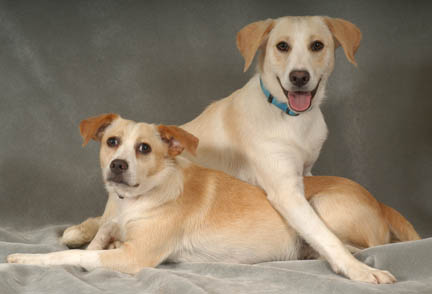Raising Two Pups at a Time: Why It's a Bad Idea

I am constantly asked if I think it's a good idea to buy two puppies and raise them together, or people ask what I think about getting their older dog a puppy to keep the older dog company.
My answer is simple for most people: "NO! It's not a good idea!"
In fact, back when I bred dogs, I would not sell 2 of my puppies to people that want to raise them together. There are several reasons for this. Let me explain it a little further:
- It's difficult enough to raise one pup and give it the socialization that it needs. Two-puppy homes almost always end up with dogs that only get half of the amount of time they need to be properly socialized.
- Dogs are pack animals. This is a much stronger drive than the average pet owner understands. People think that their little puppy comes from an animal that has been socialized for thousands of years, so how could this have any negative effect on them.
- When puppies are raised together, they become what we call DOGGY. This means they look at the other dog as their buddy and not the human that owns it. Dogs that are raised to run together often don't develop the kind of human bond that they would have had if they had been raised in a one-dog family.
- These dogs are more difficult to train. Because they don't have a strong human bond, they don't have the desire to engage their owners as much as those raised alone.
- All dogs have a very strong pack instinct. The more dogs in a pack, the stronger the instinct becomes. Raising two dogs together means an elevated pack drive. Raising 3 dogs means an even higher pack drive.
Pack drive issues mean RANK ISSUES within the pack. Establishing RANK can often mean dog fights. Don't kid yourself that your 5-pound little lap dog will not fight with its 5-pound littermate. This can become a big deal. This means dog fights when the dogs reach maturity (18 to 30 months of age). Read the article I wrote titled Dealing with a Dominant Dog.
If you wonder what the worst-case scenario could be, read my article about a pack of 3 Rotts that killed an 11-year-old boy. The owner is now serving 12 years in prison for murder, and I am proud of the fact that my testimony helped put her there.
So elevated pack drive means that one or more of the dogs is going to become the alpha dog. This means dominance problems with the other dogs, family members, and guests. It results in dogs becoming more territorial and more aggressive.
People can have more than one dog if they do it right. I currently have 10 or 12 dogs and we are raising 3 puppies. But they are all kenneled separately, and we do not allow them to play together. The only time I ever recommend 2 or 3 dogs being together is when there is the PACK LEADER there that the dogs respect to control their behavior.
You may want to read the article I wrote titled The Groundwork to Becoming a Pack Leader.
If you plan on raising two dogs (whether it's two pups or a pup and an adult) it is important they are never left together unattended. When I monitor them and see one trying to get snotty with one of the other dogs, I control the situation. I NEVER ALLOW dogs to settle things themselves by fighting. Many novice pet owners too often do this. That's counterproductive to being a pack leader. Pack members expect the pack leader to control things. Pack members respect a pack leader who protects them from bullies.
So if you are going to do what Cindy and I are doing (raising 3 pups at the same time), you had better go out and get three dog crates and expect to spend a great deal of individual time with your puppies. Most intelligent normal people don't do what we do. Think long and hard before you try it.
Adding a Third Dog to the Family
I also do not recommend adding a third dog to a family, unless the people fully understand the implications of pack behavior. In other words, if your plan is to add a male pup and not keep the dog separated from the other dogs when you are not with the dogs, then do not do it.
The new pup is going to be low in the pack order and the other dogs are going to remind him of this all the time. They may get along fine, but one is always going to be the alpha dog. When a third puppy is added to this pack it will always be the low dog, and the middle dog will be all too quick to remind it of that. This will continue until the pup is 18 months to 30 months old and at that point, many dogs who have lived together will start to fight.
The key to adding another dog is to keep the dogs separated from the existing dogs when you are not there. I don't allow my pups to even play with older dogs until the pups are 5 to 9 months old (or in some cases even older).
If you do not have a home with dog runs in the backyard, you can accomplish the same thing by using dog crates. Either keep the pup crated when you are gone or when it is out of the crate, keep the other dogs crated.
This does not mean that these dogs can never be allowed to play and run together. They can, but play with the pup needs to ALWAYS be supervised. If the older dogs get down on the pup, you are there to stop it.
Just as importantly, when the pup starts to mature and feel its oats around older dogs, it is your responsibility to protect the older dogs. This is especially important if the older dog is very old. If you don't control the pup from beating up on an old dog, the old dog is going to spend the rest of his life in fear and sadness. Older geriatric dogs will go into depression. So remember it's your job to teach your pup manners.
If you don't think this is serious, read the comments from my How to Break Up a Dog Fight Without Getting Hurt article. Several of these people have been bitten in dog fights, have seen dogs get hurt in dog fights, and even experienced dogs themselves being killed in dog fights.
Having said all this, it isn't impossible to raise multiple dogs in your home and provide a safe environment. Read my article on Introducing a New Dog into a Home with Other Dogs. You should also be aware of potential pack structure problems that may come up. Read a few of the emails I've received on problems caused by a lack of pack structure.









